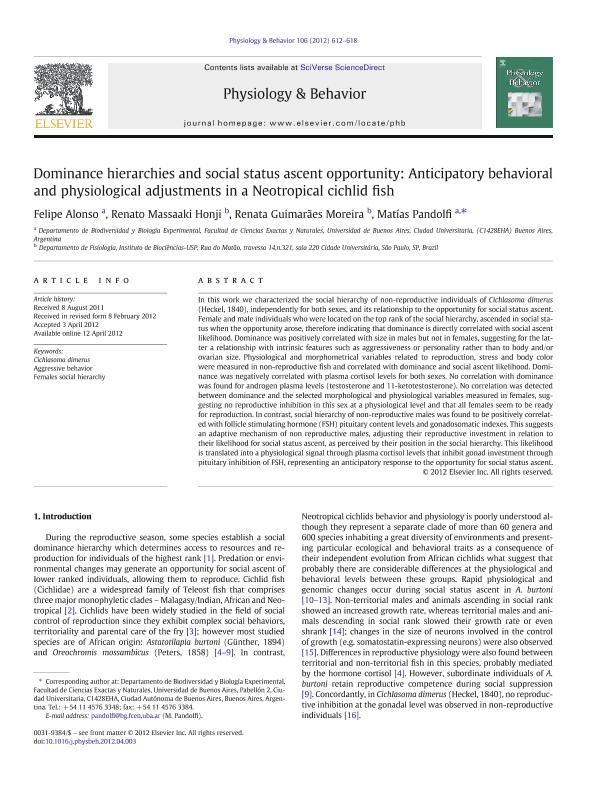Mostrar el registro sencillo del ítem
dc.contributor.author
Alonso, Felipe

dc.contributor.author
Honji, Renato Massaaki

dc.contributor.author
Moreira, Renata Guimarães
dc.contributor.author
Pandolfi, Matias

dc.date.available
2019-01-09T22:44:11Z
dc.date.issued
2012-07
dc.identifier.citation
Alonso, Felipe; Honji, Renato Massaaki; Moreira, Renata Guimarães; Pandolfi, Matias; Dominance hierarchies and social status ascent opportunity: Anticipatory behavioral and physiological adjustments in a Neotropical cichlid fish; Pergamon-Elsevier Science Ltd; Physiology And Behavior; 106; 5; 7-2012; 612-618
dc.identifier.issn
0031-9384
dc.identifier.uri
http://hdl.handle.net/11336/67878
dc.description.abstract
In this work we characterized the social hierarchy of non-reproductive individuals of Cichlasoma dimerus (Heckel, 1840), independently for both sexes, and its relationship to the opportunity for social status ascent. Female and male individuals who were located on the top rank of the social hierarchy, ascended in social status when the opportunity arose, therefore indicating that dominance is directly correlated with social ascent likelihood. Dominance was positively correlated with size in males but not in females, suggesting for the latter a relationship with intrinsic features such as aggressiveness or personality rather than to body and/or ovarian size. Physiological and morphometrical variables related to reproduction, stress and body color were measured in non-reproductive fish and correlated with dominance and social ascent likelihood. Dominance was negatively correlated with plasma cortisol levels for both sexes. No correlation with dominance was found for androgen plasma levels (testosterone and 11-ketotestosterone). No correlation was detected between dominance and the selected morphological and physiological variables measured in females, suggesting no reproductive inhibition in this sex at a physiological level and that all females seem to be ready for reproduction. In contrast, social hierarchy of non-reproductive males was found to be positively correlated with follicle stimulating hormone (FSH) pituitary content levels and gonadosomatic indexes. This suggests an adaptive mechanism of non reproductive males, adjusting their reproductive investment in relation to their likelihood for social status ascent, as perceived by their position in the social hierarchy. This likelihood is translated into a physiological signal through plasma cortisol levels that inhibit gonad investment through pituitary inhibition of FSH, representing an anticipatory response to the opportunity for social status ascent.
dc.format
application/pdf
dc.language.iso
eng
dc.publisher
Pergamon-Elsevier Science Ltd

dc.rights
info:eu-repo/semantics/openAccess
dc.rights.uri
https://creativecommons.org/licenses/by-nc-nd/2.5/ar/
dc.subject
Aggressive Behavior
dc.subject
Cichlasoma Dimerus
dc.subject
Females Social Hierarchy
dc.subject.classification
Otras Ciencias Biológicas

dc.subject.classification
Ciencias Biológicas

dc.subject.classification
CIENCIAS NATURALES Y EXACTAS

dc.title
Dominance hierarchies and social status ascent opportunity: Anticipatory behavioral and physiological adjustments in a Neotropical cichlid fish
dc.type
info:eu-repo/semantics/article
dc.type
info:ar-repo/semantics/artículo
dc.type
info:eu-repo/semantics/publishedVersion
dc.date.updated
2019-01-09T18:16:21Z
dc.journal.volume
106
dc.journal.number
5
dc.journal.pagination
612-618
dc.journal.pais
Estados Unidos

dc.description.fil
Fil: Alonso, Felipe. Universidad de Buenos Aires. Facultad de Ciencias Exactas y Naturales. Departamento de Biodiversidad y Biología Experimental; Argentina. Consejo Nacional de Investigaciones Científicas y Técnicas; Argentina
dc.description.fil
Fil: Honji, Renato Massaaki. Universidade de Sao Paulo; Brasil. Consejo Nacional de Investigaciones Científicas y Técnicas; Argentina
dc.description.fil
Fil: Moreira, Renata Guimarães. Universidade de Sao Paulo; Brasil
dc.description.fil
Fil: Pandolfi, Matias. Universidad de Buenos Aires. Facultad de Ciencias Exactas y Naturales. Departamento de Biodiversidad y Biología Experimental; Argentina. Consejo Nacional de Investigaciones Científicas y Técnicas; Argentina
dc.journal.title
Physiology And Behavior

dc.relation.alternativeid
info:eu-repo/semantics/altIdentifier/doi/http://dx.doi.org/10.1016/j.physbeh.2012.04.003
dc.relation.alternativeid
info:eu-repo/semantics/altIdentifier/url/https://www.sciencedirect.com/science/article/pii/S0031938412001448
Archivos asociados
